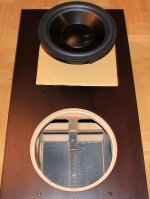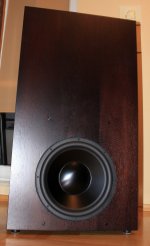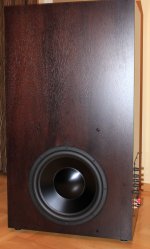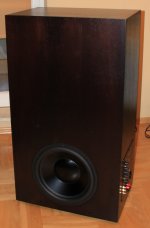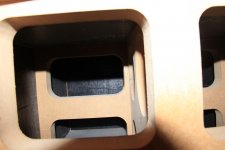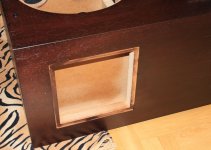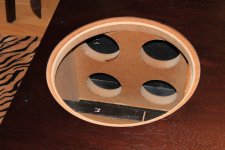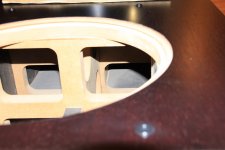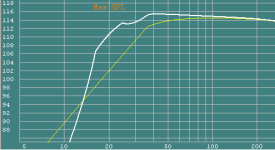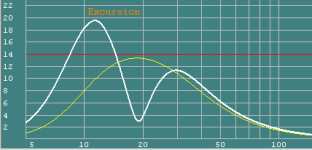Introduction
The project was created for a friend. Initially, there were attempts to buy the factory subwoofer, but finding a subwoofer with desirable characteristics as good prices happened after simply not realistic, came the decision to design Super Subwoofer.
Construction
Design intent:
very low lower frequency range below 20 Hz
very good impulse response.
As we care for the very good impulse response design was based on a closed box! This resulted in That the size of the housing is simply a large external dimensions are 1.1 x 0.62 x 0.41 m and a total gross volume of 0.279 m3 (279L) brutto and netto 180 liters. As a speaker was chosen mighty Dayton RSS390HF. To drive the whole amplifier was used HYPEX DS4 reflected a near 400 W into 4 ohms (actually some 320W). Although I Consider That it is not too strong in the clean 500W inches would not hurt, of course, the amplifier operates in class D. Enclosure speaker, of course, been properly calculated .
It was used for the construction of MDF with a thickness of 38mm with additional reinforcements in the middle.
The whole was then finished wood veneer.
More on web site:
High End Subwoofer 20 ? 100 Hz ENG | RfLab


The project was created for a friend. Initially, there were attempts to buy the factory subwoofer, but finding a subwoofer with desirable characteristics as good prices happened after simply not realistic, came the decision to design Super Subwoofer.
Construction
Design intent:
very low lower frequency range below 20 Hz
very good impulse response.
As we care for the very good impulse response design was based on a closed box! This resulted in That the size of the housing is simply a large external dimensions are 1.1 x 0.62 x 0.41 m and a total gross volume of 0.279 m3 (279L) brutto and netto 180 liters. As a speaker was chosen mighty Dayton RSS390HF. To drive the whole amplifier was used HYPEX DS4 reflected a near 400 W into 4 ohms (actually some 320W). Although I Consider That it is not too strong in the clean 500W inches would not hurt, of course, the amplifier operates in class D. Enclosure speaker, of course, been properly calculated .
It was used for the construction of MDF with a thickness of 38mm with additional reinforcements in the middle.
The whole was then finished wood veneer.
More on web site:
High End Subwoofer 20 ? 100 Hz ENG | RfLab

An externally hosted image should be here but it was not working when we last tested it.

Attachments
Good impulse means fast, which means high frequincies which means a sub dosnt do it. Take an impulse signal (one cycle of a very short duration square wave ) and put it thru a low pass filter of 100hz. And see what happens. No impulse left.
Don't know how many times I've seen people say a fast subwoofer, it's like saying a fast tractor, they don't exist, and they don't have to, it would be useless.
Don't know how many times I've seen people say a fast subwoofer, it's like saying a fast tractor, they don't exist, and they don't have to, it would be useless.
Myself, I crunched the numbers for this driver & got a substantially smaller enclosure for a Qtc of 0.71...that said, his choice has the enclosure a bit larger than twice the volume...driving down Qtc...towards that "transient perfect" zone. Since it graphs out as a nice gentle slope (at least at 0.71)...he seems to want to try approaching zero "ringing", damped performance, but will need some equalization to bring 20 Hz. to zero Db. At least 9 Db. Just don't try to get those 16Hz. signals from a pipe organ...those will have fallen too fall, "off the cliff".
----------------------------------------------------------------------Rick.............
----------------------------------------------------------------------Rick.............
Myself, I crunched the numbers for this driver & got a substantially smaller enclosure for a Qtc of 0.71...that said, his choice has the enclosure a bit larger than twice the volume...driving down Qtc...towards that "transient perfect" zone.
?? Did you follow the OP's link?
The Qts he gives is 0.42 and Vas is 281.8 litres. I chuck the numbers into a calculator and get 153 litres - close enough to the OP's 180 litres.
My calculator shows a -3dB point at 30Hz: same as the OP.
My rules of thumb (for doing quick comparisons of drivers, or double checking that I've done a calculation right)
Qts of 0.35 --> sealed box size should be ~1/3 the VAS
Qts of 0.50 --> sealed box size should be ~equal to the VAS
My rule of thumb says 0.42 should require a box somewhere between these extremes, (very) roughly 2/3 of the VAS.
I sim it as about 7dB down at 20Hz. This, very roughly, is equal to the gain in a typical room.will need some equalization to bring 20 Hz. to zero Db. At least 9 Db. Just don't try to get those 16Hz. signals from a pipe organ...those will have fallen too fall, "off the cliff".
http://www.data-bass.com/images/content/80/D main position system average gain.jpg
Hi i simmed the driver both ways with the T/S you showed. Several specs are different than quoted in the link on your www ? Dayton Audio RSS390HF-4 15" Reference HF Subwoofer 4 Ohm
Both boxes Net internal Vol = 180L & with a 24db HPF @ 10Hz
BR box fb = 19Hz
White = Bass Reflex - Yellow = Closed
The BR seems a lot better in many ways !
Both boxes Net internal Vol = 180L & with a 24db HPF @ 10Hz
BR box fb = 19Hz
White = Bass Reflex - Yellow = Closed
The BR seems a lot better in many ways !
Attachments
Good impulse means fast, which means high frequincies which means a sub dosnt do it. Take an impulse signal (one cycle of a very short duration square wave ) and put it thru a low pass filter of 100hz. And see what happens. No impulse left.
Don't know how many times I've seen people say a fast subwoofer, it's like saying a fast tractor, they don't exist, and they don't have to, it would be useless.
what do you mean when you say fast? every octave you increase excursion by 4x the excursion to maintain output. so by your definition subs woofers are slow. its not that the acceleration is slower its the distance traveled by the cone to play they sinewave. also might i add that high transient response isn't limited to mids or highs. subwoofers or often asked to changes signals just as quickly and or play signals within a signal under heavy excursion..
the woofer i have has a LE of 1.34mH it will play will into hte mid range and is "tight" very well controlled and very accurate. this is a combination of adequate dampening motor strength low distortion and low inductance.
Hi i simmed the driver both ways with the T/S you showed. Several specs are different than quoted in the link on your www ? Dayton Audio RSS390HF-4 15" Reference HF Subwoofer 4 Ohm
Both boxes Net internal Vol = 180L & with a 24db HPF @ 10Hz
BR box fb = 19Hz
White = Bass Reflex - Yellow = Closed
The BR seems a lot better in many ways !
Wow, everyone's a critic! I think it's a good, simple build.
BR / sealed might depend on what the user prefers. I like sealed cos they are easy to get right. Also, placement and room effects are important:
I sim the sealed box as -7dB at 20Hz.
In this linked article, they show +8dB at 20Hz for corner placement, relative to a outdoors measurement.
So, with room gain, which normal simulators do not show, the sealed box should sound better, in-room.
Data-Bass
There seems to be an increasing number of builds like this (sealed boxes with 18" and larger woofers), and I think it for exactly this reason: the roll-off slope and room gain sum nicely.
What kind of software to measure / sim?
This is the stuff I have tried:
REW + a USB microphone (about $100) + a PC are good for taking a lot of detailed measurements of individual points. This is widely used. Many of the images in the article I linked are from REW.
For subwoofer setup, a cheaper option (assuming you have a smartphone) could be better. You can buy AudioTool and the Dayton Audio iMM-6 for a total of $20.
You can play noise (static) through the speakers, slowly walk the phone across your listening area, with AudioTool set to "Averaging" mode, and immediately get the info you need to set eq.
With a smartphone app + mic, you can also put the subwoofer in the listening seat (playing noise), and then push your phone around the floor (with "Averaging" turned off) to look for the spot where the sub will be flattest.
Originally Posted by maxbit
What kind of software to measure / sim?
To sim i used WinISD WinISD - Linearteam
Originally Posted by hollowboy
Wow, everyone's a critic!
Critique & critic are Not the same ! I didn't say it was crap etc, just showed it's limitations, compared to a BR. I would be glad if someone had taken the time to do it for me
what do you mean when you say fast? every octave you increase excursion by 4x the excursion to maintain output. so by your definition subs woofers are slow. its not that the acceleration is slower its the distance traveled by the cone to play they sinewave. also might i add that high transient response isn't limited to mids or highs. subwoofers or often asked to changes signals just as quickly and or play signals within a signal under heavy excursion..
the woofer i have has a LE of 1.34mH it will play will into hte mid range and is "tight" very well controlled and very accurate. this is a combination of adequate dampening motor strength low distortion and low inductance.[/QUOTE
Subs do not have a good transient response. I'm talking about a woofer that is cutoff at a 100hz. As I said before, take a signal with a fast transient and run it thru a HPF, what's left. No transient. Why is this so hard for people to understand. A subwoofer is not a kick drum.
A drivers max acceleration happens at max excursion and max freq. so as long as a sub can do a clean 100hz at full power it's fast enough.
Subs do not have a good transient response. I'm talking about a woofer that is cutoff at a 100hz. As I said before, take a signal with a fast transient and run it thru a HPF, what's left. No transient. Why is this so hard for people to understand. A subwoofer is not a kick drum.
A drivers max acceleration happens at max excursion and max freq. so as long as a sub can do a clean 100hz at full power it's fast enough.
Well said that man! This should be in block capitals in the title of the Subwoofer section...
To me, a fast subwoofer is one that does not use energy storage mechanisms to establish the response curve.
Horns are the fastest, infinite baffle as well.
Reflex, t-line, fourth and sixth order speakers require time for the signal to rise to the proper level. I tend to not like mushy response.
John
Horns are the fastest, infinite baffle as well.
Reflex, t-line, fourth and sixth order speakers require time for the signal to rise to the proper level. I tend to not like mushy response.
John
+1
Needlessly pedantic to suppose the experience ""fast" woofer" relates only to tone compass. There are all kinds of flavours of sound from speakers and some of those flavours seem, well, "fast" and some, um, not fast.
I had the misfortune to be exposed to a lot of bad bar and theatre sound this past weekend, of a sort I found particularly noxious. Very punchy (and very loud and punchy) but not very low. I bet they were spot-on some sim from JBL. If you're not used to bass below 50 Hz (in speakers or live music)*, maybe some folks would consider that "fast" and tight or even just swell.
Just sayin'.
Ben
*which is what you get with the speakers I heard, likely with heavy cones that take big power and small boxes
Needlessly pedantic to suppose the experience ""fast" woofer" relates only to tone compass. There are all kinds of flavours of sound from speakers and some of those flavours seem, well, "fast" and some, um, not fast.
I had the misfortune to be exposed to a lot of bad bar and theatre sound this past weekend, of a sort I found particularly noxious. Very punchy (and very loud and punchy) but not very low. I bet they were spot-on some sim from JBL. If you're not used to bass below 50 Hz (in speakers or live music)*, maybe some folks would consider that "fast" and tight or even just swell.
Just sayin'.
Ben
*which is what you get with the speakers I heard, likely with heavy cones that take big power and small boxes
Many of the bars tend to go with cheaper stuff, not looking for real lows but the 50 hz punch only. Also, many don't have the luxury of room to put big cabs.
Bars in or near residential areas also tend to get into noise ordinance problems when they push deep bass as it tends to ignore structures of the building, raising more complaints.
Of course, enforcement is a big problem because the laws tend to not address the lower register, nor explain how to measure it properly. Eventually, it leads to a harassment type of enforcement, such as underage drinking checks as well as drug and prostitution stings. It would be simpler to just drop the lower bass and try to be a nice neighbor...
John
Bars in or near residential areas also tend to get into noise ordinance problems when they push deep bass as it tends to ignore structures of the building, raising more complaints.
Of course, enforcement is a big problem because the laws tend to not address the lower register, nor explain how to measure it properly. Eventually, it leads to a harassment type of enforcement, such as underage drinking checks as well as drug and prostitution stings. It would be simpler to just drop the lower bass and try to be a nice neighbor...
John
Thanks for those good insights.Many of the bars tend to go with cheaper stuff, not looking for real lows but the 50 hz punch only
But about "flavours", not something you'll find in Hornresp, but real never the less. When doing "design by eyeball" with a sim, many folks end up with small boxes that have (for reasons I have no sympathy for) Qs they crave and flatness. That pushes the low end cut off way up and so defining a "flavour" of sound.
Again, as jneutron discussed earlier about the major shortcoming politely called "group delay". That's flavour.
BTW, the folks in my "full-range" electrostatic speaker circle are forever moaning about finding the right sub to blend in with their ESL sound. Half the replies are sympathetic and half not at all.
Ben
Last edited:
Throw low inductance 18" woofer into sealed, cross it 1st order 70-80hz and you got nice bottom end to 4-way speaker.Good impulse means fast, which means high frequincies which means a sub dosnt do it. Take an impulse signal (one cycle of a very short duration square wave ) and put it thru a low pass filter of 100hz. And see what happens. No impulse left.
Don't know how many times I've seen people say a fast subwoofer, it's like saying a fast tractor, they don't exist, and they don't have to, it would be useless.
may i say fast tractor
https://www.youtube.com/watch?v=iq9AY6uyaB8
Throw low inductance 18" woofer into sealed, cross it 1st order 70-80hz and you got nice bottom end to 4-way speaker.
may i say fast tractor
https://www.youtube.com/watch?v=iq9AY6uyaB8
That tractor has the kind of transient response I appreciate!
In the USA semi truck cabs are also called "tractors", I've seen quite a few geared to do well over 100 MPH.
There are both "fast" and "slow" tractors and subs, though the "slow" subs are generally energy storage- jneutron must not have heard Cerwin Vega's folded horn subs if he thinks all horns are the "fastest"
Art
That tractor has the kind of transient response I appreciate!
In the USA semi truck cabs are also called "tractors", I've seen quite a few geared to do well over 100 MPH.
There are both "fast" and "slow" tractors and subs, though the "slow" subs are generally energy storage- jneutron must not have heard Cerwin Vega's folded horn subs if he thinks all horns are the "fastest"
Art
What I consider "fast" is a transducer/coupling system which does not require a resonance mechanism to achieve the output efficiency the system is touted as having.
If a specific manufacturer chooses design criteria such that other issues arise, that is not a flaw of the theory but rather a choice they have made gearing the response towards their target market. Have you any idea as to what specific choice they made that you do not like? Or is it possible that the vendor name is the issue? My last interaction with CV's was back in '79, I didn't like them because they used circuit breakers on the highs, the club my friend played at had them very high over the dance floor so not easily accessible. So, quite often the system ended up with no mids/highs in addition to no low bass..
John
- Status
- This old topic is closed. If you want to reopen this topic, contact a moderator using the "Report Post" button.
- Home
- Loudspeakers
- Subwoofers
- Big High End Subwoofer 20 Hz
